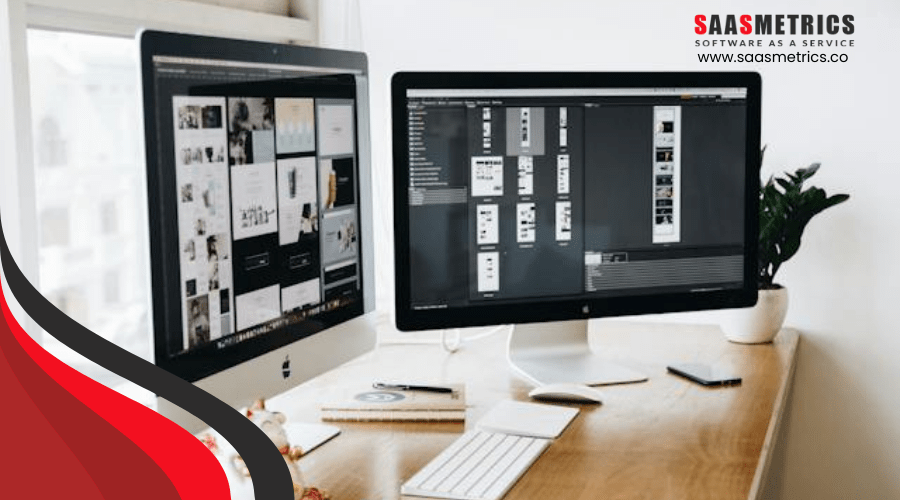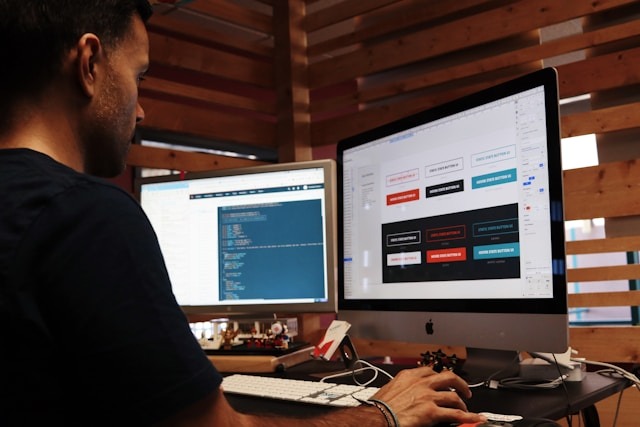If you ever thought the intersection of SaaS and web design was impossible, it’s time to think again. SaaS is disrupting the web design industry, with designers getting easy access to top-notch tools without complicated installations or hefty fees.
In fact, SaaS is leveling the web design playing field. Solo freelancers and small agencies can now access the same powerful tools as larger firms. No need for deep pockets. The monthly subscription model removes the high upfront costs. More people can create quality websites. The result? Fierce competition, yes, but also rapid industry evolution.
In this post, we’ll explore key trends and developments. We’ll see how SaaS and web design intersect. And we’ll look at how this is changing the work of designers everywhere.
Benefits of Design-Focused SaaS
Affordable Access
Before SaaS, quality tools were pricey. They often required a significant upfront investment. Now, you pay a small monthly fee. It levels the playing field for freelancers and small agencies. You get to use world-class design platforms without burning a hole in your pocket.
Template Boom
Templates are now ubiquitous, thanks to SaaS platforms like Wix and Squarespace. These platforms offer a variety of ready-made designs. It saves time. But it also presents a challenge: How to make websites unique? The trick lies in using templates as a starting point, not the finish line. Customize and make each project unique.
Seamless Teamwork
Forget long email threads and versioning headaches. SaaS platforms are cloud-based. Team members can collaborate in real-time. They can work from different corners of the globe. The result? A streamlined, more creative design process.
Auto-updates
Updates are now automatic. No more manual downloading. Designers get new features without lifting a finger. It leaves more time for what’s important: designing.
Specialized Design
New, specialized SaaS platforms are emerging. Some are geared toward portfolio sites, others toward online stores. These platforms offer tailored features for specific needs. Designers can thus offer targeted, niche solutions.
Eco-Friendly Shift
Sustainability is making its way into web design. Some SaaS platforms are offering tools for eco-friendly design. Lighter code. Less server load. Now, creating a green website isn’t just possible; it’s easier than ever.
Mobile Focus
Mobile traffic is huge, and design-focused SaaS platforms are taking note. They now offer robust mobile-responsive design tools. Designers can ensure a seamless user experience, whether the viewer is on a desktop or smartphone.
The Next Frontier: Web Design As a Service
If you’re already wowed by the way SaaS is shaking up web design, hold onto your hat. There’s another paradigm shift on the horizon: Web Design as a Service (WDaaS). This isn’t about buying design tools on a subscription model. It’s about subscribing to the design itself. Imagine a situation where your website is an ongoing service, not a one-off project. It’s always fresh, always updated, thanks to a design team you pay monthly, much like a utility bill. The implications of this for designers are huge.
A Consistent Revenue Stream
Starting with the key aspect, i.e. earrings, it’s clear that designers usually work on a project-to-project basis. They design a site, get paid, and then it’s on to the next one. WDaaS changes that. Designers can now have a consistent income stream. Think of it as design on retainer. Clients pay each month for site maintenance, updates, and even complete overhauls. No more feast-or-famine cycles. This can bring a significant shift in how design agencies operate.
Keeping Things Fresh
WDaaS means the design is never done. The benefit? Websites never get stale. With ongoing subscriptions, designers can offer continuous updates. Think seasonal redesigns. Monthly graphics swaps. Even weekly content updates. All this keeps a website fresh and engaging. And that’s good for both users and search engines.
Long-term Client Relationships
This service model fosters long-term relationships. No longer is it a one-and-done deal. Designers stay in touch with clients. They get a deep understanding of the client’s needs. And with that, they can offer more targeted designs. It becomes a partnership, not a transaction.
Cost-Effective for Clients
From a client’s perspective, WDaaS is a win. Initial setup costs are often lower. Monthly fees cover regular updates. So there’s no need for budget-busting redesigns every few years. It’s a predictable, manageable expense.
Examples of WDaaS in Action
Some agencies are already pioneering this model. Take Design as a Service firms like ManyPixels or Design Pickle. They offer unlimited graphic design tasks for a flat monthly fee. While not pure web design, these services point to the potential of the WDaaS model. They show how ongoing relationships can provide value, month after month.
The Upskill Imperative
But WDaaS has its challenges. To offer ongoing design, you have to stay ahead of trends. Continuous learning is crucial. Designers need to master not just the basics, but also whatever’s next. Think VR interfaces, AR experiences, or whatever tech comes down the pipe. The demand for a wide skill set is higher than ever.
Automation Meets Creativity
As with SaaS, automation plays a role in WDaaS. Routine tasks like site backups or basic updates can be automated. This frees up time for more creative work. Designers can focus on what machines can’t do: truly creative design.
Focus on User Experience
The WDaaS model could place an unprecedented focus on user experience (UX). Because the design is an ongoing process, designers can implement user feedback immediately. No more waiting for the next redesign cycle to tweak a feature that users find cumbersome. This could drastically improve website usability and customer satisfaction.
Real Examples: The Growth of “Headless”
The concept of “headless” CMS platforms like Contentful and Sanity.io is a real-world nod towards this trend. In a headless setup, the back-end and front-end are decoupled. This allows for ongoing design changes without affecting the underlying architecture. It’s an example of how the industry is already moving towards more flexible, adaptable solutions.
Vertical Integration
Vertical integration might become a key business strategy. In a WDaaS model, an agency could offer everything from content creation to analytics monitoring. With one team overseeing all aspects, the design becomes more cohesive. It’s easier to implement changes when all the pieces of the puzzle are in-house.
Data Security and Ethics
With the service-based approach comes great responsibility. Designers will continuously be handling client data and possibly even customer data. Strong security protocols will be essential. Ethical considerations around data usage will also come to the forefront.
Tailoring to Specific Markets
WDaaS models could allow for ultra-specific customization for various industries. For example, a web design service geared towards healthcare might have built-in compliance checks for regulations like HIPAA in the U.S. A design service for e-commerce could offer built-in cart abandonment prevention features.
Scaling Customization wih Innovation
Beyond SaaS and WDaaS, the web design industry is ripe for other innovative shifts. One such area of growth is scaling customization and the evolution of specialized design tools. Let’s delve into these new frontiers.
AI Makes Custom Design Easy
Think AI is just science fiction? Think again. Designers are now using AI to make websites that change based on who’s visiting. This means the design itself could adapt to suit a viewer’s taste, from the layout to the color scheme. This isn’t the future—it’s happening now.
Forget One-Size-Fits-All: Modular Design Is Here
Time is money, especially if you’re freelancing or running a small agency. Modular design saves both. It’s like having a box of Legos, but for websites. Snap together different pre-made design elements like headers, footers, or product features. You get a custom look without starting from zero each time.
Tiny Details, Big Impact
Micro-interactions are small design moves that guide your site’s visitors. Think of the little animations that pop up when you fill out a form.. They make a website feel more interactive and can guide the user on how to move around the page.
Special Tools for Special Jobs
Not all design needs are the same. So why should all design tools be? Now we see more niche SaaS tools coming up. Some focus only on text. Others are all about animations. Designers can go deep into specific areas and really show off their skills.
Faster, Smarter, Better
Website speed is no joke. If your site is slow, people leave. New tools let designers check how fast a site is in real-time. If something’s wrong, you can fix it on the spot. No more guessing
Voice Search is Taking The Reigns
People are using voice search a lot, so web design has to catch up. Creating a design that works well with voice search isn’t the same as traditional design. The focus here is on natural language and easy navigation. It’s a new skill, but it’s one that’s worth learning.
Widgets and Add-Ons for Developers
Think SaaS in web design is just for designers? Think again. Developers are relishing this change as well. In the past, mundane tasks ate up their hours. Now, they’re free to focus on what they love: innovation. They create custom widgets and clever add-ons, offering extras like bursts of emojis or instant customer service chat. With SaaS platforms actively seeking such inventive contributions, developers too have found their space in the SaaS landscape
Up-to-date Software
Next on the list is software longevity. Outdated software used to be a big headache—slow, glitchy, and insecure. SaaS offers a fresh take. With a monthly subscription, you’re always on the latest version. Should a hiccup occur, customer support is right there. It’s a win-win: you get a streamlined design process and peace of mind.
Data: The Unseen Co-Designer
So, what follows a stellar design and updated software? Insights from data. SaaS platforms don’t just offer design tools; they gather data—oodles of it. This data isn’t just for show; it informs design choices, making your websites smarter. Even better, you don’t need to be a data expert to understand it. Many platforms offer built-in analytics tools, simple enough for anyone to use and often compatible with third-party platforms like Google Analytics.
Conclusion
SaaS and web design are blending in powerful ways. This mix boosts designers, developers, and agencies. As Web Design as a Service (WDaaS) gains traction, the future of the web design looks bright.
To recap:
SaaS models level the field. They make design tools easy to get for freelancers and small agencies.
- Cloud-based platforms change how teams work. They make collaboration easy and creative.
- New SaaS platforms meet niche needs. They make customization simple.
- This new model could change the game. It could offer steady income for designers and keep websites current.
- SaaS platforms offer more than tools. They provide data that guides better design.
There you have it: a multi-faceted look at how SaaS is revolutionizing web design for everyone involved. Over time, it’s only going to get better and more refined.








